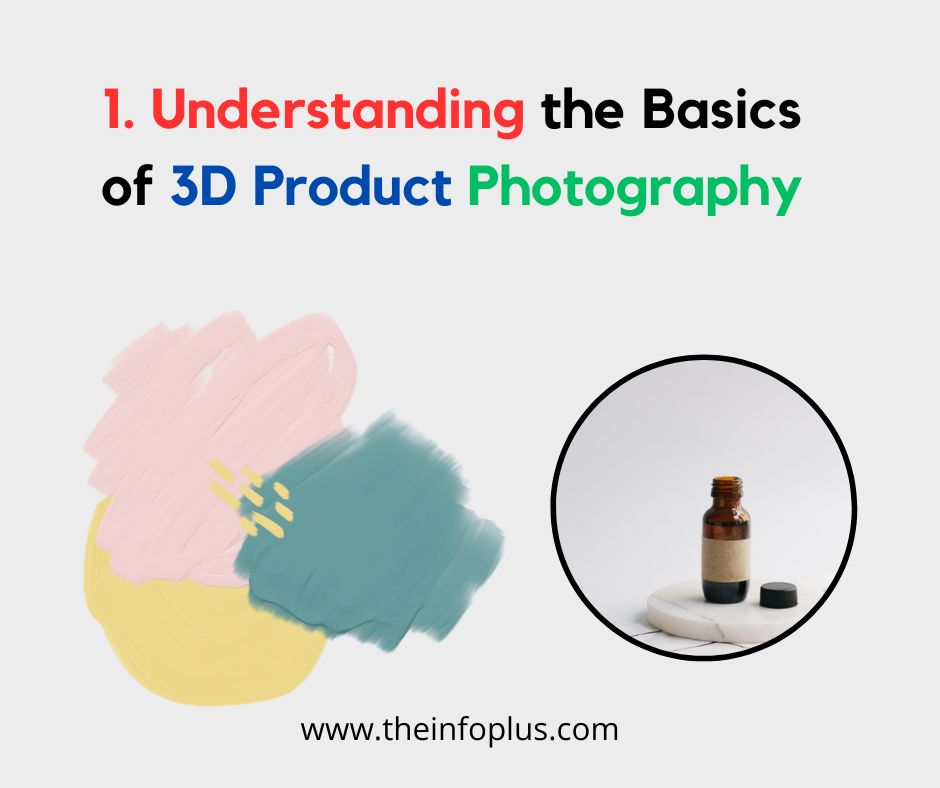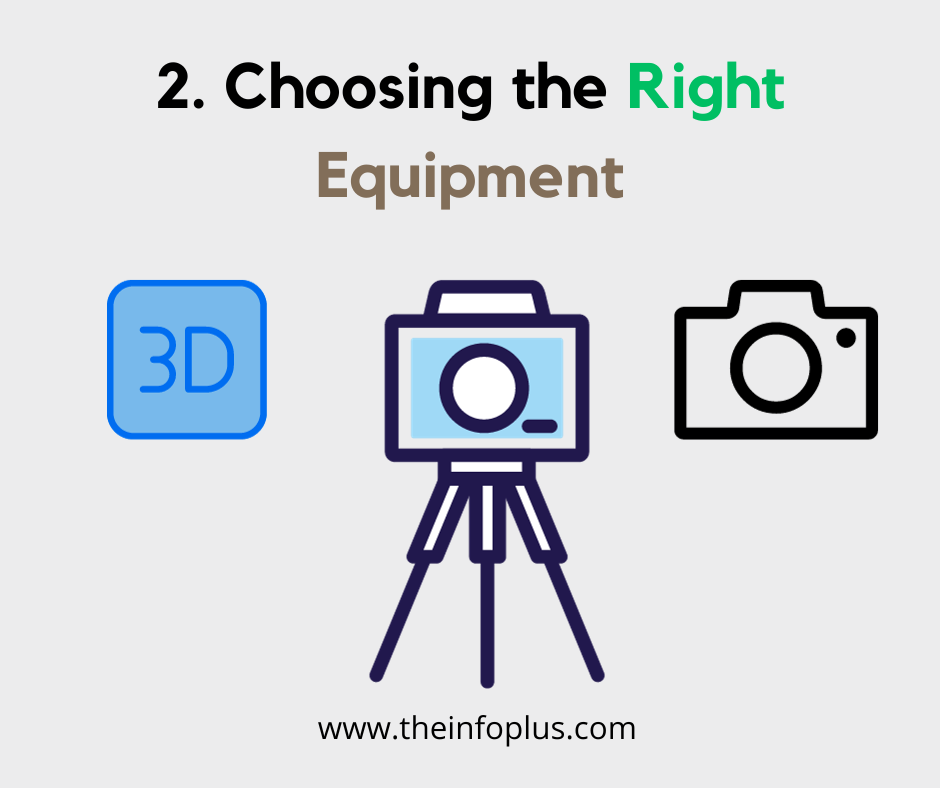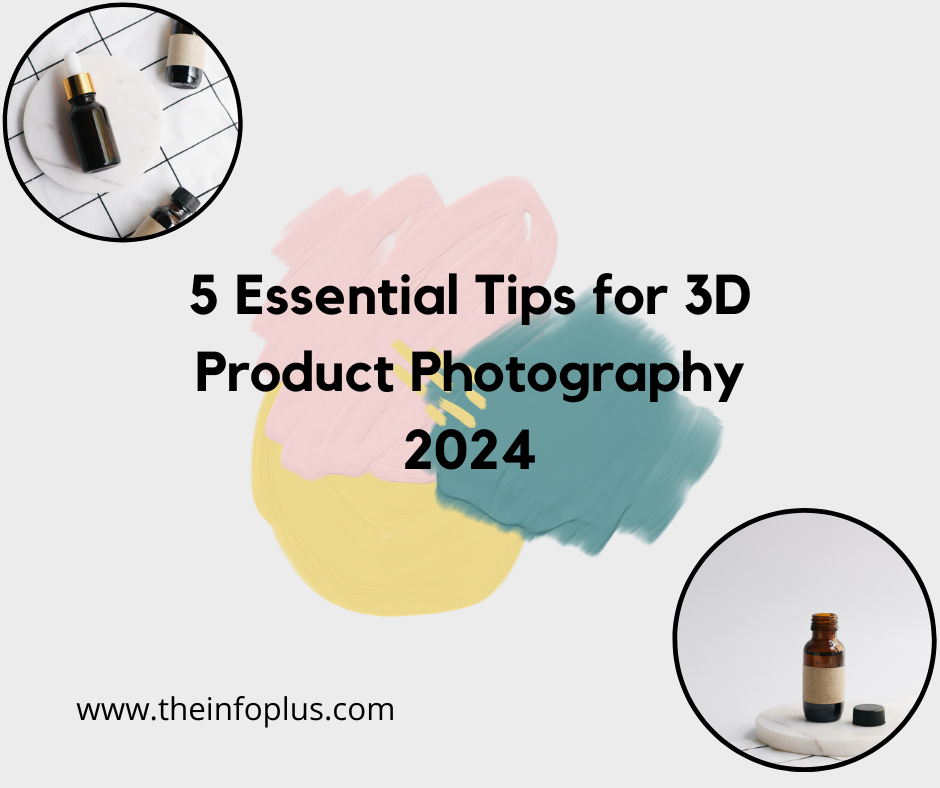According to Info Blogger In today’s generation, beautiful graphics are more important than ever, especially for 2024 e-commerce businesses. Many techniques are available and 3d photography is a game changer. Here are five crucial techniques for mastering this art form if you want to boost your product presentation and captivate potential buyers.
The digital marketplace is inundated with products vying for consumer attention. To stand out, businesses must harness the power of high-quality visuals, and 3D product photography offers a compelling solution. This article delves into the intricacies of creating stunning 3D product images that captivate audiences and drive sales.
1. Understanding the Basics of 3D Product Photography

3D product photography is photographing things from various perspectives in order to generate a three-dimensional depiction. In contrast to traditional photography, which concentrates on two-dimensional photos, 3D photography adds depth and realism to products, increasing their attractiveness. Understanding this distinction is critical if you want to maximize the potential of 3D images in your micro marketing efforts.
What is 3D Product Photography ?
3D product photography involves capturing a product from multiple views to generate a (3D) three-dimensional representation. Unlike traditional photography that produces static (2D) two-dimensional images, 3D photography employs specialized techniques and equipment to create a dynamic visual experience for the viewers. By capturing a product from various perspectives, including top, bottom, sides, and angles, 3D photography provides viewers with a comprehensive view, allowing them to interact with the product virtually. For businesses in the digital generation, such immersive visuals, especially when considering CGI product photography, offer a powerful tool for engaging consumers and presenting products in a more dynamic and compelling manner.
Benefits of 3D Product Photography
- Enhanced Visual Experience : 3D product photography offers customers a more immersive and interactive shopping experience by providing a comprehensive view of products from multiple angles. This quality visual experience increases consumer confidence and reduces uncertainty, and that will increase your sales.
- Increased Engagement : Engaging visuals capture the attention of customers and encourage users to spend more time interacting with products photos. By providing a 360-degree view of products, 3D photography captivates audiences, encouraging them to explore products in detail, leading to increased engagement and brand loyalty.
- Reduced Returns : Product graphics that are clear and comprehensive decrease uncertainty and give consumers a true portrayal of items. By precisely displaying objects from all angles, 3D photography reduces misinterpretations and assures customers receive things that fulfil their expectations, lowering returns and increasing customer happiness.
Main Features of 3D Product Photography
- Depth and Realism : Unlike traditional photography, which captures things in two dimensions, 3D product photography adds depth and realism by displaying objects from various perspectives, resulting in a more lifelike picture that connects with customers.
- Interactive Viewing : Users may virtually engage with things by rotating and zooming in on photos in 3D product photography, creating a more immersive and engaging purchasing experience.
- Comprehensive Product Visualizations : By capturing objects from many views, such as top, bottom, sides, and angles, 3D photography provides consumers with a full picture, allowing them to properly analyze things and make educated purchase decisions.
2. Choosing the Right Equipment

When it comes to 3D product photography, choosing the right equipment is critical to producing amazing images. Not only does the appropriate equipment improve the quality of your photographs, but it also streamlines the whole photographic process, assuring efficiency and consistency. This article will go over the necessary equipment for 3D product photography and give insights to help you make educated selections.
1. Camera Selection
- High-Resolution Camera : To properly capture fine details and textures, choose a camera with a high megapixel count. Professional photographers prefer DSLR and mirrorless cameras because of their higher image quality and mobility.
- Macro Lens : Invest in a high-quality macro lens to take close-up photographs of products that showcase subtle details and textures. Macro lenses have a shallow depth of field, which allows you to create spectacular bokeh effects and highlight specific elements.
2. Lighting Equipment
- Continuous Lighting : To successfully illuminate your products, invest in a set of continuous lighting equipment, such as saltboxes, LED panels, or strobe lights. Continuous lighting provides steady illumination, allowing you to easily manipulate shadows, highlights, and reflections.
- Light Modifiers : Utilize light modifiers, such as diffusers, reflectors, and grids, to manipulate light and achieve desired lighting effects. Diffusers soften harsh light, reflectors fill in shadows, and grids control light spill, providing you with greater flexibility and control over your lighting setup.
3. Turntable and Product Staging
- Product Turntable : A rotating turntable is essential for capturing 360-degree views of your products systematically. Choose a motorized turntable with adjustable speed settings to control the rotation speed and capture smooth, consistent rotations.
- Backdrop and Product Staging : Select a neutral backdrop, such as a seamless paper roll or fabric backdrop, to minimise distractions and focus viewers’ attention on your products. Utilize props and product staging tools, such as acrylic risers, platforms, and holders, to showcase products effectively and create depth and dimension in your images.
4. Post-Processing Software
- Editing Software : Invest in reputable post-processing software, such as Adobe Photoshop or Lightroom, to edit and enhance your 3D product images effectively. Familiarize yourself with essential editing techniques, such as colour correction, retouching, and image compositing, to refine your images and ensure they meet industry standards.
3. Mastering Lighting Techniques
Lighting is the foundation of photography, and mastering lighting techniques is essential for creating great 3D product shots. Proper lighting highlights product features, textures, and colours, increasing overall visual appeal and grabbing visitors’ attention. In this comprehensive book, we’ll go over fundamental lighting techniques and strategies to help you efficiently grasp 3D product photography lighting.
1. Understand the Fundamentals of Light
- Directional Lighting : Experiment with several lighting angles, such as front, side, and back lighting, to decide which lighting direction is most attractive and impactful for your products. When situating lighting to successfully accentuate characteristics, consider the product’s shape, texture, and reflecting capabilities.
- Light Quality : Understand the difference between hard and soft light and their respective effects on products. Soft light minimizes harsh shadows and highlights, creating a flattering and even illumination that enhances product details and textures. Utilize diffusers, reflectors, and light modifiers to manipulate light quality and achieve desired lighting effects.
2. Utilize Light Modifiers Effectively
- Diffusers: Soften harsh light and minimise shadows by utilising diffusers, such as softboxes, umbrellas, and scrims. Diffusers spread light evenly, creating a flattering illumination that enhances product details and minimises imperfections.
- Reflectors: Fill in shadows and add dimension to your images by using reflectors to bounce light back onto your products. Silver, gold, and white reflectors offer varying levels of reflection and warmth, allowing you to customize the lighting and achieve desired effects.
- Grids and Snoots: Control light spill and focus illumination on specific areas of your products by using grids and snoots. Grids and snoots narrow the light beam, providing precise control over light direction and creating dramatic lighting effects.
3. Create Depth and Dimension
- Three-Point Lighting: Implement the three-point lighting technique, consisting of key, fill, and backlighting, to create depth and dimension in your 3D product images. The key light illuminates your product, the fill light reduces shadows, and the backlight separates your product from the background, creating a three-dimensional effect.
- Highlight and Shadow Control: Manipulate highlights and shadows to emphasise product features effectively. Experiment with lighting ratios, angles, and intensities to control contrast and create depth, highlighting textures, shapes, and details.
4. Consider the Product’s Material and Finish
- Reflective Surfaces: Manage reflections and glare when photographing products with reflective surfaces, such as glass, metal, and glossy materials. Position lights strategically, use polarizing filters, and adjust camera angles to minimise reflections and capture clear, detailed images.
- Matte Finishes: Highlight textures and subtle details when photographing products with matte finishes, such as fabrics, plastics, and ceramics. Utilize soft, diffuse lighting to create even illumination, revealing product nuances and enhancing visual appeal.
4. Setting the Perfect Stage
Creating visually compelling 3D product images goes beyond mastering camera settings and lighting techniques. Setting the perfect stage plays a pivotal role in highlighting product features, enhancing aesthetics, and captivating your audience’s attention. In this guide, we’ll explore essential tips and strategies to help you craft an impeccable stage for your 3D product photography endeavors.
1. Define Your Product’s Story and Purpose
- Product Narrative: Establish a clear and compelling product narrative that resonates with your target audience. Understand your product’s unique selling points, features, and benefits, and incorporate them into your photography staging to create a cohesive and impactful visual story.
- Target Audience: Identify your target audience’s preferences, interests, and motivations. Tailor your staging elements, props, and backgrounds to appeal to your audience’s aesthetic sensibilities and lifestyle aspirations, enhancing engagement and connection.
2. Choose the Right Background and Props
- Neutral Backdrops: opt for neutral backdrops, such as seamless paper rolls, fabric backdrops, or minimalist settings, to minimize distractions and focus viewers’ attention on your products. Choose colors, textures, and patterns that complement your product’s colour palette and style, creating a harmonious and cohesive visual experience.
- Props and Accessories: Select props and accessories that enhance your product’s features, functionality, and aesthetics. Incorporate relevant props, such as lifestyle elements, complementary products, or contextual items, to create a relatable and aspirational scene that showcases your product in action or in its intended environment.
3. Arrange Products Strategically
- Product Positioning: Arrange products strategically to create depth, dimension, and visual interest. Experiment with product placement, angles, and compositions to highlight key features, emphasize unique selling points, and evoke desired emotions and responses from viewers.
- Layering and Stacking: Incorporate layering, stacking, and overlapping techniques to add visual complexity and depth to your compositions. Utilized platforms, risers, and stands to elevate products, create shadows, and introduce dynamic elements that enhance aesthetics and storytelling.
5. Post-Processing and Editing Tips
Post-processing and editing are indispensable steps in the 3D product photography workflow, allowing you to refine, enhance, and perfect your images for optimal visual impact. By leveraging the power of post-processing software and applying advanced editing techniques, you can transform your raw captures into stunning, high-quality images that captivate audiences and drive sales. In this guide, we’ll explore essential post-processing and editing tips to help you elevate your 3D product photography to the next level.
1. Choose the Right Post-Processing Software
- Industry-Leading Software : Invest in reputable post-processing software, such as Adobe Photoshop, Lightroom, Capture One, or specialized 3D rendering software, to edit and enhance your 3D product images effectively. Familiarize yourself with the software’s features, tools, and capabilities to maximize efficiency and creativity during the editing process.
2. Master Basic Editing Techniques
- Color Correction: Adjust colour balance, temperature, saturation, and vibrancy to ensure accurate and consistent colours across your 3D product images. Use colour correction tools, such as white balance adjustments, colour grading, and selective colour adjustments, to enhance product aesthetics and appeal.
- Exposure and Contrast: Fine-tune exposure, contrast, highlights, and shadows to optimize brightness, detail, and tonal range in your 3D product images. Utilize exposure adjustment tools, histogram analysis, and tone curve adjustments to achieve balanced and visually pleasing exposures that highlight product features and textures.
Conclusion – 3D Product Photography
According to Info Blogger 3D product photography emerges as a game-changing technique for the ever-changing field of digital marketing and e-commerce in 2024, It’s providing quality visual experiences that capture customers or online users and drive interaction. 3D product photography, by overcoming the boundaries of traditional 2D imaging. It’s also enables businesses to present products in immersive, dynamic, and interactive ways, increasing user experiences, and ultimately increasing sales and conversions.
In the end, 3D product photography represents more than a trending photography. By investing in 3D product photography, businesses can change user experience through providing quality photography, unlock new opportunities in their business, elevate their brand presence, and cultivate lasting relationships with consumers in today’s digital-centric world. Embrace the future of product visualization with 3D photography and redefine your brand’s visual narrative, customer experience, and bottom line.

Can provide a link mass to your website https://zetds.seychellesyoga.com/info
kindly mail us : mitmehta2019@gmail.com
I offer mutually beneficial cooperation https://zetds.seychellesyoga.com/info
kindly mail us : mitmehta2019@gmail.com
Content for your website https://ztd.bardou.online/adm
Kindly mail us mitmehta2019@gmail.com
Content for your website http://myngirls.online/
Kindly mail us mitmehta2019@gmail.com
Can provide a link mass to your website http://myngirls.online/
Kindly mail us mitmehta2019@gmail.com
Content for your website http://fertus.shop/info/
Kindly mail us mitmehta2019@gmail.com
Can provide a link mass to your website http://fertus.shop/info/
Kindly mail us mitmehta2019@gmail.com
Content for your website http://fertus.shop/info/
kindly mail us : mitmehta2019@gmail.com
Can provide a link mass to your website http://fertus.shop/info/
kindly mail us : mitmehta2019@gmail.com